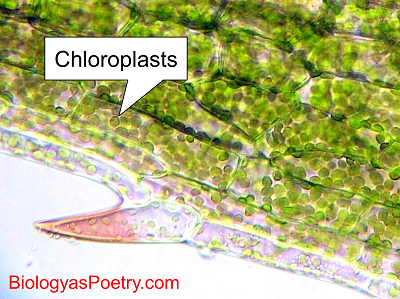∞ generated and posted on 2016.08.30 ∞
Endosymbiotic organelle that is responsible for photosynthesis in eukaryotic organisms and which otherwise is equivalent to free-living cyanobacteria.
Chloroplasts technically are plastids which, in turn, are endosymbiotic organelles that are capable of taking on a variety of forms and functions, ones that are in addition to photosynthesizing. All eukaryotic algae possess chloroplasts as too do all plants.
Chloroplasts, like mitochondria and other endosymbionts, posses bacterial chromosomes, though the majority of proteins found associated with chloroplasts are actually expressed by nuclear rather than chloroplast genes.

Figure legend: Wet mount of the aquatic plant, elodea, with chloroplasts (green, circular organelles) prominently displayed.
The acquisition of plastids by eukaryotic organisms has occurred multiple times but the acquisition of a cyanobacterium as a chloroplast appears to have happened only once, at least among surviving photosynthetic lineages. All other photosynthetic endosymbiotic events instead appear to have involved the acquisition of eukaryotic algae as endosymbionts of eukaryotic algae, so-called secondary and tertiary endosymbiotic events.